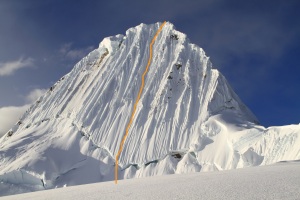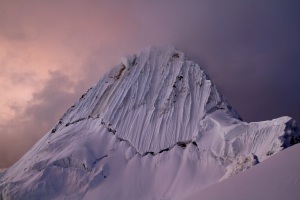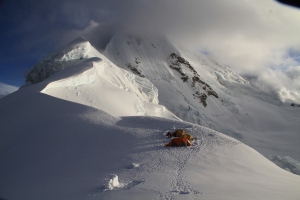 [/caption]
[/caption][caption id="attachment_53" align="alignleft" width="300" caption="Alpamayo - 19,511'"]
 [/caption]
[/caption]I can say from my experience in climbing with Erik Weihenmayer that there is more to climbing than just seeing the objective. It is the journey, the camaraderie, and the aesthetics of the environment that include sound, feel, movement, smell and the rush of cold air over the skin. The exhilaration of achieving a goal and the physical challenge of climbing difficult pitches at extreme altitude. The mountain demands precision in planning, and in moving, which make the challenge all the more enjoyable when success is somehow won.
[caption id="attachment_48" align="alignright" width="300" caption="Wilakwain - 1,500 years old"]
 [/caption]
[/caption]The journey began as we met our local guide and outfitter Rodrigo at the Lima airport. Having made some poor communications we had no idea that he would be there to meet us and had made our own arrangements for a taxi, hotel, bus, and porter - all of which we had to cancel at the sight of Rodrigo and his sign which read: Eric and Erik. Flights arrive late in the night and busses leave early in the morning. Not a big deal because there is plenty of rest to be had on an eight-hour ride to the town of Huaraz at 10,500 feet. The bus leaves from sea level and travels over a 13,000 foot pass at about 10 mph and I believe I could make the same drive in my own car in about 3 hours vs the eight that the bus takes. As we got organized for the climb we would acclimate and take some short hikes around this area which is the gateway to the Cordillera Blanca. The first was to see the Incan ruins of Wilkawain, and taste some new exotic fruits that Rodrigo had purchased at the open market on our way walking out-of-town.
We were on an aggressive schedule and did not want to spend too much time here in Huaraz. We hit the road the next day driving to the trailhead at Cashapamapa. This for me is the scariest part of the trek. Riding in a large van with small tires, fully overloaded on a narrow, dirt road that is uneven, worn, and washed out in the corners that hangs high above the valley makes a person wish they were blind. The drop might be huge, and an accident would mean certain death, but at least the driver is going recklessly fast! With the mules loaded, the bell on my finger, and Erik behind me listening for that familiar ring to show the way - we were off for a grand climb.
[caption id="attachment_49" align="alignleft" width="300" caption="Beasts of burden"]
 [/caption]
[/caption]The scenery is stunning, which makes this a very popular trek. The peaks rise high above the Santa Cruz valley with their icy white caps contrasting the lush, green, river valley below. The trees were flowering around us and cascades of water rushed out of the canyon walls with force and regularity. The constant roar of the water made for difficult communication, and therefore navigation, which made avoiding the ubiquitous evidence of our bovine residents impossible, the result of which was greasy, stinky feet. As the miles went by the evidence of the cows only increased - so much so that I really can't recommend this route as a trek. The cows were in the water, on the trail, in the camps, and many times nearly in my tent! It was either the cows doing their business in the river, or some poor hand washing which led to contaminated food that gave us all a reason to run to the bathroom multiple times daily. It saps strength and energy and dehydrates a person as well making an already difficult summit that much harder to attain.
The camp by the river was serene, but the next day as we made it to Alpamayo Base Camp we were greeted by a scene even sweeter. I would not have been surprised that while camped here we would receive a visit from a few waywardly Hobbits. We entered via a large, flat ,open meadow with one large boulder in the middle. Being the nice guy I am I made sure blind Erik climbed over this giant boulder on our way into camp without telling him there was no need to surmount the obstacle. Still 2,000 feet below the glacier we rested in a forest of Quinwahl trees on the edge of the moraine. From this 14,000 foot high camp we would launch upwards onto the mountain. Coming down the trail as we headed up were a couple of groups of climbers that had decided to turn around when they deemed the route out of condition and "unclimbable". The group was made up of two fit european men and two Peruvian guides. When we told them our objective, they laughed and said "you'll see." We continued on knowing conditions can change over the course of a few days and that we could well determine for ourselves if the route would go or not.
[caption id="attachment_50" align="alignleft" width="300" caption="Moraine Camp"]
 [/caption]
[/caption]From Moraine Camp the real work began: moving over the glacier, carrying a heavy pack, walking as a rope team, and even employing my ice-axe. Things moved along smoothly even though Rodrigo on the front of the rope would go well out of his way to make sure blind Erik did not have to step across any open crevasses - which were small and well within Erik's ability. It wasn't until we climbed a sixty degree pitch leading directly into Col Camp that we got, or at least I got, my first view of the route in all its splendor. The mountain from this angle, from this proximity was jaw dropping in beauty and in the stark reality that it looked like it would be hard to tame. The sun went down as our tent went up, the mountain illuminated in an orange, pink and purple hue which almost made this frigid place feel warm - almost.
The climb commenced at 1:30 in the morning. It was the typical alpine start that allows for safer climbing before the sun hits and loosens big projectiles above the route. With Erik in the middle my job was to cast my headlamp towards his feet to ensure that they would not lead him into a crevasse while at the same time being alert as to where I would step and avoid that same fate. Quickly we were roped and moving up the mountain in 70 meter pitches - the most our ropes would allow. The deep snow at the bottom slowed our progress but was by no means
[caption id="attachment_51" align="alignleft" width="300" caption="The Alpine Start"]
 [/caption]
[/caption]insurmountable as the other climbers would have had us believe. The bergschrund was a brief 20 feet of ice climbing, and after two pitches we were beginning to swing into solid ice. The route is called the french direct after two french climbers who were killed by ice fall, but was originally climbed by two Americans in the 80's. We moved slowly up the 65-70 degree slopes to be cautious, but also due to the fact that we were now moving into the area of 19,000 feet with stomachs that were still not settled. I could easily determine that Erik was not having his best day as he kept his head down and his mouth shut. Words were few as we used the rope to communicate what needed to be said. A tug of the rope meant come on up, a little slack would signify a pause, and a yell would serve to say "move over left, you are off route!" Having Rodrigo along was a huge help as he could lead and leave me to direct Erik and also allow for me to take some pictures.
The climb felt solid as the tools could be sunken into good ice and the screws could be well placed. Even so small projectiles found there way to our positions at 80 mph.
[caption id="attachment_54" align="alignright" width="200" caption="In the Guts"]
 [/caption]
[/caption]In the middle of a sentence I might hear Erik scream out "ooowwww! #*%!" At which I would ask "are you okay?" then laugh only to be hit myself a
[caption id="attachment_52" align="alignright" width="300" caption="Erik W Swinging Away"]
 [/caption]
[/caption]moment later right on the upper lip "OOOwwwWW! #*%!" A good reason to keep the hood up and the head down. The day dawned in a brilliant show of light and color on these white cake frosted peaks around us, so bright and intense that with the angle of the slope our faces were just inches from the reflected light which in turn caused a significant burn. By 11:30 we had reached the summit and it appeared that the whether would hold long enough for us to get back to camp safely. The clouds rolled over the top just long enough for me to miss out on good photos, however the celebration still took place just above the hole that had to be dug so that we could get onto the summit. We rapped down the route and traversed back across the glacier to high camp; this is when I should have noticed things were awry. I had no energy. I could not keep up with the guys on the front of the rope, I felt like passing out.
[caption id="attachment_55" align="alignleft" width="300" caption="Nearly There!"]
 [/caption]
[/caption][caption id="attachment_56" align="aligncenter" width="300" caption="Burrowing through to the Summit"]
 [/caption]
[/caption]2:30 a.m. I awakened because I was having a hard time breathing. The next breath I took brought back a familiar and awful sound. There was a raspy, gurgling in my lungs which indicated I had pulmonary edema. Ten years earlier I had experienced this, but have had no problems since, and I have even been to higher elevations. In the dark of night, knowing that Erik still needed me to get him down off of the mountain, there was nothing I could do. Nothing but pray that is. I did just that; I put in my headphones and listened to praise music to drown out the sound of my breathing, I sat up, since every time I laid down the gurgling would return, and I prayed, waiting for the sun to rise to allow us to depart.
[caption id="attachment_57" align="alignleft" width="300" caption="Col Camp 18,200'"]
 [/caption]
[/caption][caption id="attachment_58" align="alignright" width="300" caption="Col Camp - Quitaraju in Background"]
 [/caption]
[/caption]If it were absolutely necessary I am sure that Rodrigo could have gotten Erik down without me, but it would have been awkward and maybe a tad unsafe, so I decided that until my condition worsened I would gut it out and remain with Erik until Base Camp. Thankfully we were able to rappel down a large section of the glacier and then walk down to Base Camp relatively quickly. Though I felt a little better, my lungs were still not clear and I knew that in the morning I would need to get down to a lower elevation ASAP. Reading some scripture gave me peace, as did the music and the fact that we were on our way down. This event certainly once again affirmed to both Erik and me that this is why he needs to climb most of the time as a party of three. If something were to happen to me and it were just the two of us, he would be left alone, on a glacier waiting for help to pass by. The element of trust is essential as is our need to make plans and be as safe as possible in executing these plans. In leaving Base Camp we changed things up a bit. Instead of guiding Erik out on foot for two days we opted for a one day horse ride for him and an eleven mile hike for me. My pack was light, and in going down my edema didn't bother me too much, but it wasn't until we were back in Lima that it totally cleared up.
[caption id="attachment_59" align="alignleft" width="300" caption="A is for effort!"]
 [/caption]
[/caption][caption id="attachment_60" align="alignright" width="300" caption="A&W on the Summit!"]
 [/caption]
[/caption]What insights did I gain from this summit? Hydrate, filter don't boil, sleep low - climb high, loyalty makes strong friendships, always bring a good book as well as THE Good Book. Never give up, give in to faith not fear.





No comments:
Post a Comment